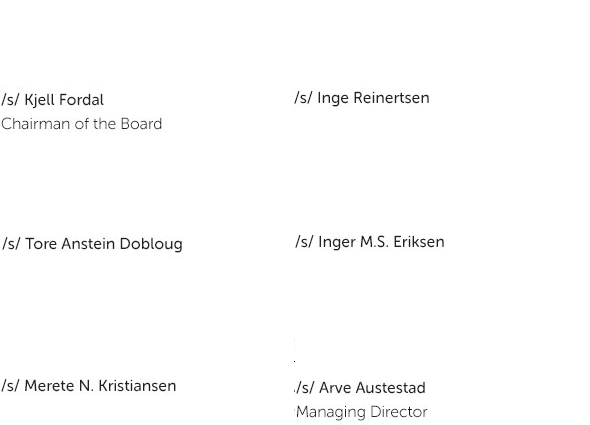Boligkreditt 1st Quarterly Report 2017
Statement of the board of directors
Cover pool and outstanding covered bonds
The cover pool consists of residential mortgages and liquid, highly rated assets (substitute assets). The amount of liquid assets varies over time and the variation is solely a result of the Issuer’s liquidity risk management (and regulatory requirements), whereby upcoming redemptions are refinanced early (up to 12 months) with proceeds held as liquid assets (please see the investor reports for details on the composition of liquid assets). Covered bonds are shown inclusive of the market value of the derivatives deployed to hedge currencies and interest rates.
Key figures cover pool
| Q1 2017 | Q4 2016 | Q3 2016 | Q2 2016 | Q1 2016 | |
|---|---|---|---|---|---|
| Weighted Average Current LTV (%) | 49.7 % | 51.1 % | 49.9 % | 49.9 % | 51.4 % |
| Weighted Average Original LTV (%) | 59.6 % | 59.4 % | 59.0 % | 58.7 % | 58.7 % |
| Average Loan Balance (NOK) | 1,340,039 | 1,322,732 | 1,306,717 | 1,286,759 | 1,272,036 |
| Number of Mortgages in Pool | 130,920 | 131,743 | 132,397 | 133,840 | 135,432 |
| Percentage of non first-lien mortgages | 0.0 % | 0.0 % | 0.0 % | 0.0 % | 0.0 % |
| Overcollateralization | 111.2 % | 108.8 % | 108.6 % | 109.0 % | 108.6 % |
Key developments in the first quarter 2017
SpareBank 1 Boligkreditt issued a new EUR benchmark covered bond in January 2017 with a maturity of 5 years, while repaying a 7 year issue from 2010 in March.
The Company also issued 1.35 billion Norwegian kroner worth of covered bonds during the first quarter, as well as a smaller amount of EUR private placements.
The residential lending volume has increased according to expectations with a small amount (1.5 billion kroner) over the first quarter of the year. The expectation is for the volume of mortgages to increase by 3 per cent for 2017, but this remains dependent on owner banks funding plans and growth through the year.
In the market for the Company’s bonds the credit spreads have generally contracted with the market during the quarter.
Boligkreditt is well capitalized with a capital coverage ratio of 16.19 per cent measured against a total capital requirement of 15.0 per cent, in addition to a moderate capital requirement for Pillar 2 requirements. Total Tier 1 capital is 14.03 and core equity capital 12.58 per cent.
SpareBank 1 Boligkreditt has a negative result for the first quarter 2017, which was also the case for the full year 2016. This is entirely due to the change in basis swap valuation adjustments, an accounting requirement, which does not impact cash flows and earnings and reverse to zero over time. The pre-tax result is a positive 42.9 million excluding the effect from revaluing basis swaps.
As of 31.12.2016 the Company reclassified its hybrid bonds from debt to equity on the balance sheet, in accordance with IFRS rules. Capital ratios are not affected by this movement of lines on the balance sheet. Interest expense on the hybrid bonds however are from 2017 charged to equity and not accounted for in the pre-tax result as interest expense. The pre-tax result of 42.9 million above (excluding basis swaps) would have been 30.9 million including the before-tax interest on the hybrid bonds.
Nature and development of the Company’s business
SpareBank 1 Boligkreditt AS is a credit institution licensed by the Norwegian Financial Services Authority (Finanstilsynet) and is operated according to the legislation for covered bond issuers in Norway which is included in the law regarding financial enterprises (“Finansieringsvirksomhetsloven”) chapter 2, section IV and the detailed regulations thereof.
The purpose of the Company is to provide funding for the owners by buying residential mortgage loans with a loan-to-value (“LTV”) of up to 75 per cent and financing these primarily through the issuance of covered bonds. The Company which is based in Stavanger, is owned by banks which are members of the SpareBank 1 Alliance. A comprehensive agreement is signed which each of the banks in the SpareBank 1 Alliance which are selling mortgages to the Company regarding the purchasing process and the obligations which the banks owe the Company and its mortgage customers (“Transfer and Servicing Agreement”, “TSA”). The Company’s operating model is to pay out to the parent banks who sell mortgages to the Company the margin earned during the course of the year (commissions to the parent banks). These commissions are deducted in the financial accounts to calculate net income.
The Company’s issuances of covered bonds mainly take place under the EUR 25,000,000,000 Global Medium Term Covered Note Programme (GMTCN Programme). This Programme was updated on June 10, 2016 and is available on the Company's home page: https://spabol.sparebank1.no.
One or more credit ratings from international rating agencies are important in order to be able to issue covered bonds. The Company have procured the services of Moody’s Ratings Service and Fitch Ratings to evaluate the credit quality of the issuances under the GMTCN Programme. The bond ratings are Aaa from Moody’s and AAA from Fitch.
Accounts for the period
The annual accounts have been prepared in accordance with the International Reporting Standards (IFRS) as adopted by the EU and published by the International Reporting Standards Board (IASB).
The Board views the accounts as presented to be a true representation of SpareBank 1 Boligkreditt’s operations and financial position at the end of the year. Numbers in brackets refer to the previous year for comparison.
The total balance sheet at the end of the of the first quarter 2017 amounts to 249 (268) billion kroner. The reduction is largely due to a decline in the value of derivatives used for hedging issued bonds and declines in associated collateral levels held. The Company had in Q1 2017 net interest income of 90.3 (112.5) million kroner, which includes deducting commissions paid to the owner banks. The cost of operations for the quarter was 8.5 (7.9) million kroner including depreciation and amortization. No additional amounts have been charged as loan provisions (write offs) in 2017 beyond the approximately 8 million kroner which has been reserved from previous years. No actual loan losses have occurred since the Company commenced operations. This produces an operating result of negative 169 million kroner (positive 140) before tax. The operating result includes a pre-tax loss due to basis swap valuation adjustments of approximately 212 million kroner. Basis swap valuation adjustments are temporary effects reversed over time until maturity of the swaps.
Lending to customers amounted to 176 (173) billion kroner as of 31.03.17. The Company’s own liquid assets as of December 31, 2016 were 26.5 (25) billion kroner. Liquid assets are cash and highly rated, highly liquid bonds which are held as a function of upcoming bond maturities up to 12 months ahead in time.
Risk aspects
SpareBank 1 Boligkreditt as an issuer of covered bonds is subject to strict rules regarding its exposure to credit, market, and liquidity risks. This fact, and the aim of the maintenance of the AAA/Aaa rating, impliesmeans that the Company is subject to low levels of risk and places strong emphasis on risk control.
Credit Risk is defined as the risk that losses can occur as a consequence of that customers and others do not have the ability or willingness to meet their obligations to SpareBank 1 Boligkreditt. Because the Company buys residential mortgages within 75% of the value of the objects on which the mortgages are secured, the Board of Directors conclude that the credit risk is lower than for banks in general.
Market risk is defined as the risk of losses due to changes in market rates, i.e. interest rates, exchange rates and the prices of financial instruments. At the end of the quarter SpareBank 1 Boligkreditt AS had issued bonds in foreign currency, in addition to Norwegian kroner denominated debt. Amounts were approximately 117 billion kroner in EUR, 30 billion kroner in USD and 0.3 billion kroner in Swedish kroner, at exchange rates at quarter-end. However, all borrowing and investments with a fixed rate and all borrowing and investments in a foreign currency have been hedged by financial currency- and/or interest rate swap agreements or through natural hedges. The collective cash flow therefore matches borrowings in Norwegian kroner with floating rate conditions (NIBOR 3 months). The Company receives collateral from its counterparties in derivative agreements according to certain criteria.
SpareBank 1 Boligkreditt AS owns bonds and treasury bills at year-end for a total of NOK 48.5 (59.5) billion kroner, whereof 22.0 (34.5) billion kroner is collateral received from counterparties in derivatives transactions and are not available for the Company as liquid assets. The bonds are Norwegian and Nordic covered bonds and German supra sovereign and agencies (German agencies guaranteed by the German government) with a triple-A rating from Fitch, Moody's and/or S&P. Deposits are placed in banks with a minimum rating of at least A/A2.
The Company had as of 31.12.2017 only moderate interest rate risk and immaterial amounts of currency risk.
Liquidity risk is defined as the risk that the Company is not able to meet its obligations at maturity or to be able to finance the purchase of loans at normal terms and conditions. Liquidity risk is managed based upon a liquidity strategy approved by the Board. According to the strategy, SpareBank 1 Boligkreditt AS shall maintain a material liquidity reserve with a minimum size of covering all maturities within 6 months and 50 per cent of all maturities between 6 and 12 months. Additionally the Company shall at any point in time be able to meet its interest payments, including derivatives, which come due in the next three months under a scenario where no interest payments are received from the loan portfolio. SpareBank 1 Boligkreditt AS’s liquidity situation is good.
Operational risk is defined as risk of loss due to error or neglect in transaction execution, weakness in the internal control or information technology systems breakdowns. Reputational, legal, ethical and competency risks are also elements of operational risk. The risk is assessed to be moderate.
The Company spends much time identifying, measuring, managing and following up central areas of risk in such a way that this contributes to meeting the strategic goals. The notes 23 to 27 in the annual report 2016 provides further information.
Future prospects of the Company
The Company has a portfolio of residential mortgage lending with an average loan to value of approximately 50 per cent and no loans are in default.
Residential real estate prices have increased overall in Norway over the year 2016 and into 2017 and stand at a high level. However, there are large regional differences and SpareBank 1 Boligkreditt’s portfolio is well diversified throughout the major city regions in all of Norway.
Due to the special characteristics and restrictions for loans to become part of the cover pool, the high degree of diversification of the pool and the continued strength of the Norwegian economy, as well as prudent lending practices (as well as new regulations) in place, the prospects for the Company are considered to be good and stable. The Board also base this conclusion on the low LTVs of the mortgages, no defaults or arrears, a strong history and institutional framework in Norway for loan performance, as well as the low unemployment environment.
Macroeconomic development 1:
The Norwegian economy expanded in 2016 by 0.8 per cent and in the fourth quarter by 1 per cent compared to the fourth quarter in 2015. The unemployment rate is now 4.2 per cent (January 2017), down from the peak of 4.9 per cent in this cycle. However, while jobs are created in many sectors, the lowered rate is partially also explained by a reduced labour force, which is now 69.7 per cent of the population, down from 71 per cent in January 2014. Private investments grew solidly over 2016, which includes business investments, but also includes strong residential construction. The construction sector responds to the market’s price signal, which exhibits a strong appreciation over 2016 and into 2017. Part of the political and regulatory programme is now to reduce this price appreciation.
Economic outlook:
The economic outlook is summarized in the table below. The GDP figures show that for the full year 2016 real growth was 0.8 per cent, which is the lowest since 2009. The stronger growth figures for 2017 and beyond express that the downturn in the Norwegian economy following the oil sector led decline and consolidation is coming to end and a cautious recovery is underway. Observable in the data is increasing private demand, increasing exports and a halt in the steep decline in offshore oil sector investments.
Significant factors have counterbalanced the oil price and oil sector lead decline (Norway’s largest industrial sector), these are government expansionary policies, including tax reductions, low interest rates and a weak and therefore export inducing currency. With the oil price between 50 and 60 USD a barrel, Norway’s existing oil and gas production is solidly profitable. Due to cost reductions, the pipeline of investment projects on the Norwegian continental shelf is also today much more economically viable compared to 2014-2015. Stability in oil prices and an expectation that European and world growth is expanding is also backing the projections for the coming years in the table below.
1 Macroeconomic projections have been sourced from Statistics Norway as of March 9, 2017.
| Projections (%) | 2017 | 2018 | 2019 | 2020 |
|---|---|---|---|---|
| GDP growth mainland | 1.8 | 2.4 | 2.2 | 2.1 |
| Unemployment rate | 4.4 | 4.2 | 4.1 | 4.1 |
| CPI growth | 2 | 2.1 | 2.2 | 2.3 |
| Annual wages increase | 2.3 | 3.1 | 3.1 | 3.9 |
Source: Statistics Norway (SSB) March 9, 2017
The Board of Directors affirms that the financial accounts present a correct and complete picture of the Company’s operations and financial position for the first quarter of 2017. The financial accounts including notes are produced under the assumption of a going concern.
There have been no incidents of a material nature after year-end which are expected to impact the quarterly accounts as of 31 March, 2017.
Stavanger, 31. March 2017 / April 27 2017
Board of Directors of SpareBank 1 Boligkreditt AS



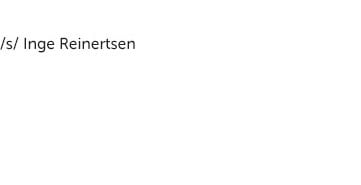


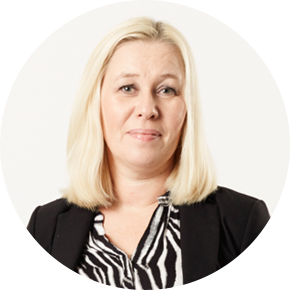
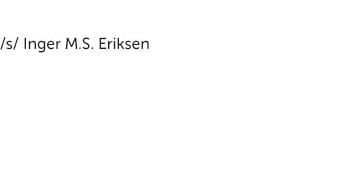

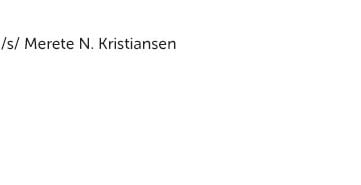

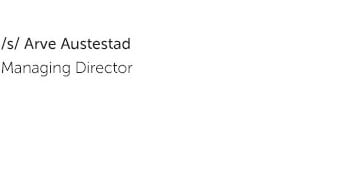
SpareBank 1 Boligkreditt AS
- Statement of the members of the board and the chief executive officer
The Board and the chief executive officer have today reviewed and approved the financial accounts for the first quarter 2017 for SpareBank 1 Boligkreditt AS. The quarterly accounts have been prepared in accordance with the International Financial Reporting Standards (IFRS), as adopted by the EU.
To the best knowledge of the board and the chief executive officer the accounts have been prepared in accordance with applicable accounting standards and give a true and fair view of the assets, liabilities, financial position and profit or loss of the company taken as a whole as of 31.03.17.
The board of directors and the chief executive officer declare to the best of their knowledge that the annual report gives a true and fair view of the development and performance of the business of the Company, as well as a description of the principal risks and uncertainties facing the Company.
Stavanger, 31. March 2017 / 2. May 2017
The Board of Directors of Sparebank 1 Boligkreditt AS
